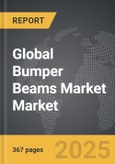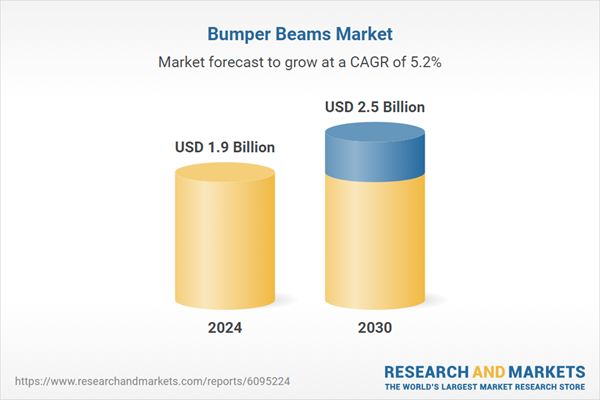Global Bumper Beams Market - Key Trends & Drivers Summarized
Why Are Bumper Beams Central to Modern Vehicle Safety and Lightweight Design?
Bumper beams have become critical components in the modern automotive industry, serving as the first line of defense in vehicle crash safety while also contributing significantly to vehicle weight optimization and fuel efficiency. Positioned behind the bumper cover, the bumper beam is designed to absorb and dissipate kinetic energy during low- and high-speed impacts, protecting key structural elements of the vehicle such as the engine, transmission, cooling systems, and, most importantly, the occupants. As safety standards grow increasingly stringent across global automotive markets, bumper beams are engineered to meet exacting crashworthiness criteria, including frontal, rear, and side impact performance. At the same time, the automotive sector's shift toward reducing overall vehicle weight - especially in electric and hybrid vehicles where battery mass is a concern - has intensified demand for lightweight yet high-strength bumper beam materials. Traditionally made from steel, bumper beams are now commonly produced using aluminum, carbon fiber composites, glass fiber-reinforced polymers (GFRPs), and even magnesium alloys, which offer superior energy absorption capabilities at significantly lower weights. This dual imperative - ensuring occupant safety while minimizing mass - has made bumper beams a focal point of innovation in automotive structural design. Additionally, bumper beams contribute to pedestrian safety by absorbing impact forces during collisions with humans, which is now a mandated design feature in many regulatory frameworks. As the automobile evolves into a safer, lighter, and more environmentally friendly machine, bumper beams are not just supporting safety - they are actively shaping the future of automotive engineering.How Are Advanced Materials and Manufacturing Innovations Redefining Bumper Beam Capabilities?
The bumper beam segment is experiencing a rapid transformation driven by material innovation and advancements in manufacturing technologies. While traditional stamped steel bumper beams continue to offer cost-effective solutions, newer materials like aluminum extrusions, thermoplastic composites, and carbon fiber-reinforced plastics are gaining significant traction for their superior strength-to-weight ratios and energy absorption properties. Aluminum beams, for instance, provide nearly 50% weight savings compared to steel while maintaining comparable crash energy management, making them especially attractive in luxury and electric vehicles. Carbon fiber and hybrid composite beams go even further, offering exceptional stiffness and crush performance, though at a higher price point. On the manufacturing side, technologies such as hot stamping, hydroforming, pultrusion, and resin transfer molding (RTM) are enabling the production of complex, lightweight bumper beam geometries with enhanced structural performance and reduced tooling costs. Automation and robotics have also made large-scale composite manufacturing more viable by reducing cycle times and ensuring consistency. Finite element analysis (FEA) and crash simulation software are increasingly used in the design phase to predict and optimize crash behavior, allowing engineers to refine bumper beam architecture before physical prototyping. Moreover, modular bumper beam designs are becoming more common, allowing the same underlying structure to be adapted across different vehicle models, which improves cost efficiency for OEMs. The integration of multi-material construction - such as combining aluminum with composite inserts or steel reinforcements - is further pushing the envelope in bumper beam performance. These innovations are not only enhancing crashworthiness but also enabling more flexible, scalable manufacturing strategies that align with the industry's broader goals of sustainability, efficiency, and mass customization.What Regulatory Pressures and Industry Trends Are Driving Market Demand for Bumper Beams?
The demand for advanced bumper beams is being heavily influenced by an evolving regulatory landscape, shifting consumer expectations, and the rapid transformation of the global automotive industry. Governments across North America, Europe, and Asia are enforcing increasingly stringent crash safety standards, which require vehicles to meet rigorous performance benchmarks in both occupant and pedestrian impact scenarios. Standards such as the U.S. Federal Motor Vehicle Safety Standards (FMVSS), Euro NCAP protocols, and UNECE regulations specify detailed impact criteria, compelling automakers to invest in high-performance bumper systems that ensure compliance. Simultaneously, the growing market penetration of electric and hybrid vehicles is reshaping bumper beam design requirements. Since these vehicles often lack traditional internal combustion engine bays to absorb crash energy, bumper beams must take on a more significant structural and energy dissipation role. Moreover, consumer awareness around vehicle safety ratings, fueled by organizations like IIHS and ANCAP, is putting pressure on automakers to score highly in crash tests, further prioritizing the optimization of bumper systems. In parallel, the industry's push toward lightweighting to meet emission and fuel economy targets - especially under frameworks like the EU's CO2 fleet targets and CAFE standards in the U.S. - has made reducing the mass of structural components like bumper beams a strategic priority. Beyond regulations, sustainability goals are encouraging the use of recyclable and low-emission materials, prompting a shift toward aluminum and thermoplastics. The integration of advanced driver assistance systems (ADAS), such as radar and sensors, into bumper assemblies also requires beams that can support without interfering with signal transmission, introducing new design complexities. All of these forces are driving the bumper beam market to continuously evolve in alignment with broader trends in safety, sustainability, and smart mobility.Which Emerging Opportunities and Strategic Trends Are Shaping the Future of the Bumper Beam Market?
The growth in the bumper beams market is driven by several emerging trends and strategic shifts that reflect the broader evolution of vehicle design, materials science, and global transportation goals. A key opportunity lies in the growing electric vehicle (EV) and autonomous vehicle segments, where structural demands are changing rapidly. In EVs, for instance, bumper beams not only serve traditional safety functions but also protect critical battery components located near the vehicle's extremities. As EV adoption surges globally - driven by government incentives, infrastructure development, and consumer interest - OEMs are looking for bumper solutions that offer exceptional energy absorption with minimal weight addition. Autonomous and semi-autonomous vehicles introduce further complexity, as sensor integration and thermal management become essential. This is opening the door for smart bumper beams that incorporate mounting provisions for LiDAR, cameras, radar, and active cooling ducts without compromising structural integrity. Another strategic trend is the localization of bumper beam manufacturing, especially in Asia-Pacific, to meet rising regional demand and reduce logistical costs. Major Tier 1 suppliers are establishing joint ventures and regional production hubs to serve OEM platforms more efficiently. Concurrently, the emphasis on sustainability and the circular economy is promoting the development of recyclable composites and closed-loop aluminum processing systems. Customization and modularity are also becoming priorities, with OEMs seeking beam solutions that can be adapted to multiple vehicle platforms through minor tooling changes. Lastly, cross-industry collaboration between automakers, material providers, and research institutions is accelerating innovation, particularly in hybrid material systems and digital twin modeling for crash testing. Together, these trends are not only expanding the functional role of bumper beams but also ensuring that they remain central to the future of safe, lightweight, and connected mobility.Report Scope
The report analyzes the Bumper Beams market, presented in terms of market value (US$). The analysis covers the key segments and geographic regions outlined below:- Segments: Type (Steel Reinforcing Beam Type, Plastic Reinforcing Beam Type, Aluminum Reinforcing Beam, Other Types); Distribution Channel (OEM Distribution Channel, Aftermarket Distribution Channel); End-Use (Passenger Cars End-Use, Commercial Vehicles End-Use).
- Geographic Regions/Countries: World; United States; Canada; Japan; China; Europe (France; Germany; Italy; United Kingdom; Spain; Russia; and Rest of Europe); Asia-Pacific (Australia; India; South Korea; and Rest of Asia-Pacific); Latin America (Argentina; Brazil; Mexico; and Rest of Latin America); Middle East (Iran; Israel; Saudi Arabia; United Arab Emirates; and Rest of Middle East); and Africa.
Key Insights:
- Market Growth: Understand the significant growth trajectory of the Steel Reinforcing Beam segment, which is expected to reach US$1.1 Billion by 2030 with a CAGR of a 6.8%. The Plastic Reinforcing Beam segment is also set to grow at 3.8% CAGR over the analysis period.
- Regional Analysis: Gain insights into the U.S. market, valued at $507.3 Million in 2024, and China, forecasted to grow at an impressive 8.6% CAGR to reach $512.7 Million by 2030. Discover growth trends in other key regions, including Japan, Canada, Germany, and the Asia-Pacific.
Why You Should Buy This Report:
- Detailed Market Analysis: Access a thorough analysis of the Global Bumper Beams Market, covering all major geographic regions and market segments.
- Competitive Insights: Get an overview of the competitive landscape, including the market presence of major players across different geographies.
- Future Trends and Drivers: Understand the key trends and drivers shaping the future of the Global Bumper Beams Market.
- Actionable Insights: Benefit from actionable insights that can help you identify new revenue opportunities and make strategic business decisions.
Key Questions Answered:
- How is the Global Bumper Beams Market expected to evolve by 2030?
- What are the main drivers and restraints affecting the market?
- Which market segments will grow the most over the forecast period?
- How will market shares for different regions and segments change by 2030?
- Who are the leading players in the market, and what are their prospects?
Report Features:
- Comprehensive Market Data: Independent analysis of annual sales and market forecasts in US$ Million from 2024 to 2030.
- In-Depth Regional Analysis: Detailed insights into key markets, including the U.S., China, Japan, Canada, Europe, Asia-Pacific, Latin America, Middle East, and Africa.
- Company Profiles: Coverage of players such as Adamant Namiki Precision Jewel Co., Ltd., Advanced Technology & Materials Co., Ltd., Amorphology, Inc., Dongguan Eontec Co., Ltd., Dongguan Yihao Metal Material Technology Co., Ltd. and more.
- Complimentary Updates: Receive free report updates for one year to keep you informed of the latest market developments.
Some of the 37 companies featured in this Bumper Beams market report include:
- Aisin Takaoka
- Benteler Deutschland
- CIE Automotive
- Donghee
- Flex-N-Gate Corporation
- Futaba Industrial
- Gestamp
- Hella GmbH & Co. KGaA
- Hutchinson
- KIRCHHOFF Automotive
- LEAD
- Lingyun Industrial
- Magna International
- Minth Group
- Plastic Omnium
- Shanghai Jiaoyun Group
- SL Corporation
- Sungwoo Hitech
- Tata AutoComp Systems
- thyssenkrupp AG
This edition integrates the latest global trade and economic shifts into comprehensive market analysis. Key updates include:
- Tariff and Trade Impact: Insights into global tariff negotiations across 180+ countries, with analysis of supply chain turbulence, sourcing disruptions, and geographic realignment. Special focus on 2025 as a pivotal year for trade tensions, including updated perspectives on the Trump-era tariffs.
- Adjusted Forecasts and Analytics: Revised global and regional market forecasts through 2030, incorporating tariff effects, economic uncertainty, and structural changes in globalization. Includes historical analysis from 2015 to 2023.
- Strategic Market Dynamics: Evaluation of revised market prospects, regional outlooks, and key economic indicators such as population and urbanization trends.
- Innovation & Technology Trends: Latest developments in product and process innovation, emerging technologies, and key industry drivers shaping the competitive landscape.
- Competitive Intelligence: Updated global market share estimates for 2025, competitive positioning of major players (Strong/Active/Niche/Trivial), and refined focus on leading global brands and core players.
- Expert Insight & Commentary: Strategic analysis from economists, trade experts, and domain specialists to contextualize market shifts and identify emerging opportunities.
Table of Contents
Companies Mentioned (Partial List)
A selection of companies mentioned in this report includes, but is not limited to:
- Aisin Takaoka
- Benteler Deutschland
- CIE Automotive
- Donghee
- Flex-N-Gate Corporation
- Futaba Industrial
- Gestamp
- Hella GmbH & Co. KGaA
- Hutchinson
- KIRCHHOFF Automotive
- LEAD
- Lingyun Industrial
- Magna International
- Minth Group
- Plastic Omnium
- Shanghai Jiaoyun Group
- SL Corporation
- Sungwoo Hitech
- Tata AutoComp Systems
- thyssenkrupp AG
Table Information
| Report Attribute | Details |
|---|---|
| No. of Pages | 367 |
| Published | December 2025 |
| Forecast Period | 2024 - 2030 |
| Estimated Market Value ( USD | $ 1.9 Billion |
| Forecasted Market Value ( USD | $ 2.5 Billion |
| Compound Annual Growth Rate | 5.2% |
| Regions Covered | Global |









